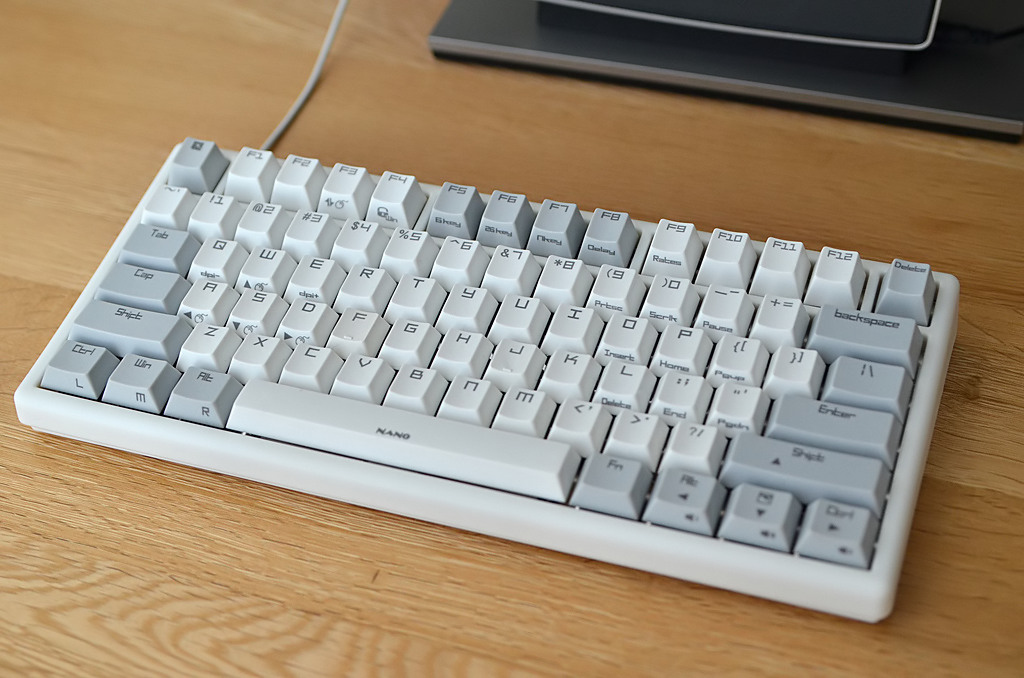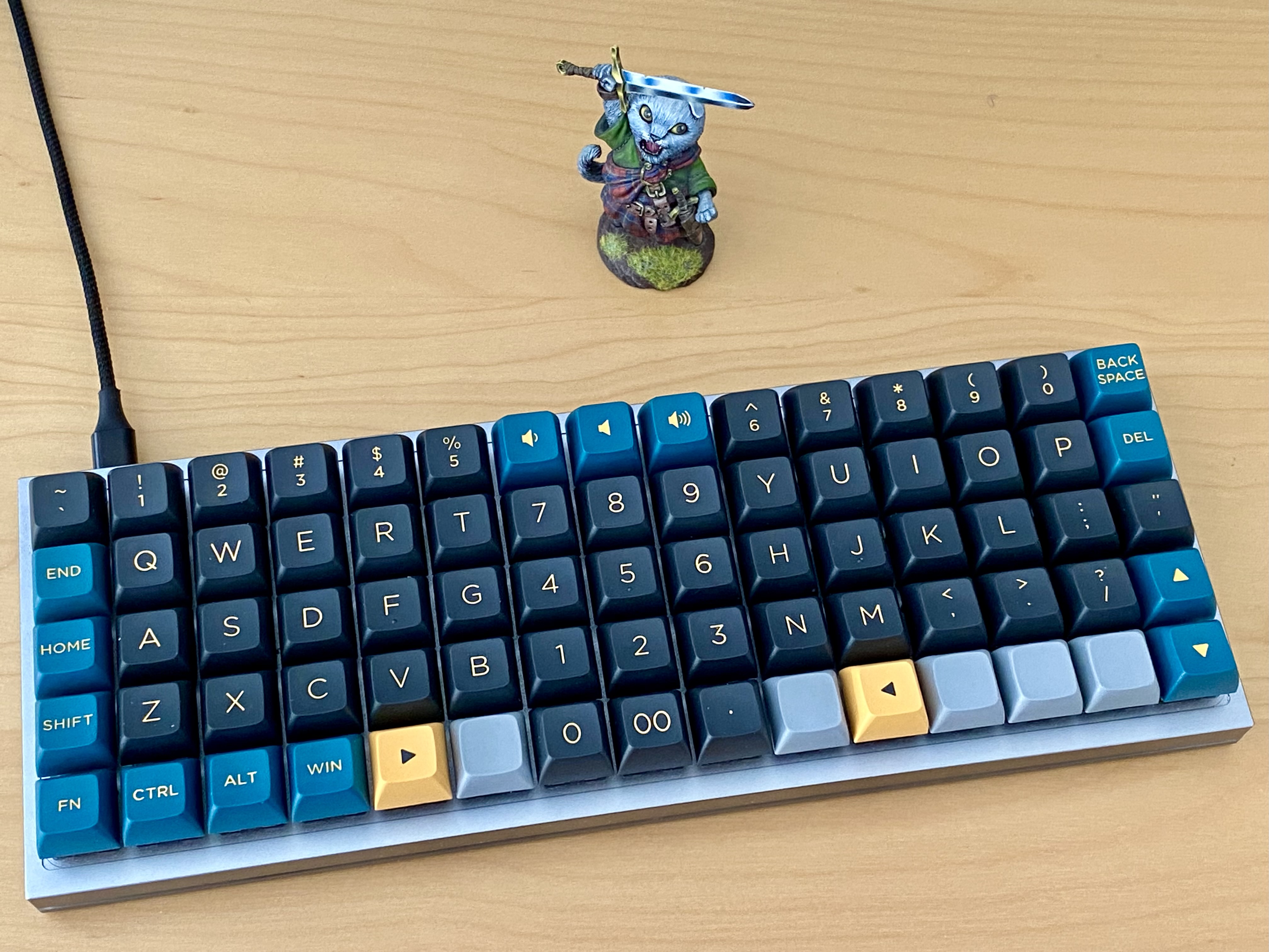Almost exactly a year ago in early February 2023 I managed to finally kill my main keyboard that I had since 2014, a Noppoo Nano 75-S. It had Cherry MX Red switches and was one of the cheapest mechanical keyboards I could find at the time because I wanted to “try” one before committing to something better and more expensive like a Matias Ergo Pro.

The Nano turned out to be much better than I expected and I stuck with it for the next nine years until the fatal tea spill that eroded one of the columns. All the while, I knew I’d eventually replace it but wasn’t in a hurry. Four main things made it stand out for me:
- I was lucky with the red switches. Often people buy a mechanical keyboard and hate it because of the switches—too loud or too mushy. The reds were quiet, lightweight and worked great both for work and gaming.
- PBT keycaps for life! Usually laptops and random keyboards have ABS keycaps that develop a shine after a year or two. The Nano had PBT keycaps that are much more durable than ABS and after nine years of all-day use (and a good cleaning) they look exactly like new. Noppoo used an ugly font on the legends but I really liked the retro white-gray color scheme.
- The layout that I picked accidentally turned out to be near-perfect. (I will write a whole separate post about it because it’s worth it.) In short, I was happy that it had several features at once: ANSI base, the F-row, arrows but at the same time no extra keys on the right to accommodate the arrows (which is rare). I might even have bought something else after a few years but the layout was too good and I couldn’t find anything off the shelf that matched and was just as symmetrical. Probably the closest one is KRepublic XD64-60 but it doesn’t have the F-row.
- The Nano was fully programmable which is also quite rare if you’re not building a custom keyboard or buying a PCB. It was keyboard-specific software that only ran on Windows but you could program each key individually and even assign macros if you wanted. Unlike with some gaming keyboards where you had to keep the software running, the configuration was stored on the keyboard itself. After that I never wanted to deal with non-programmable keyboards again.
The Nano had some superficial problems like accidentally repeated keys on the Mac or the ugly font, but overall it was great and I’d buy it again if I were looking for a “normal” 75%. RIP.
I had a spare tenkeyless that I used in the interim, but now I had a choice to make: what did I want next? I only knew I wasn’t so sure and wanted to have a platform that would let me experiment.
Keyboards, in my opinion, are the most important interface between you and the computer, more important than even the display. Using a keyboard lets you build and exercise muscular memory, and it brings the joy of precise physical movement to the otherwise purely intellectual activity. Switching up keyboards and layouts also keeps your brain fresh in the same way learning a language does, because typing (in my mind) is essentially the same process of transforming symbolic knowledge into physical movement—of the fingers or vocal chords.
I’m sorry to say that but how a keyboard looked was probably my most defining factor. The Nano without a doubt looked great but I wanted something more ergonomic and drifted towards ortholinear keyboards (to say simply, without the horizontal offset of the rows where your finger would move straight up and down along a column). At the same time, I wasn’t too keen on committing to a split because there were few that I liked.
While doing my research I came upon this quote that precisely expressed my sentiment (unfortunately I didn’t record the source but it was somewhere on Reddit):
I love the synergy between two popular approaches to computer-ing efficiency: 1)
Vim-like interfaces, which assign profound meaning to every single keypress; and 2) blank ortholinear rectangular keyboards, which make sure nothing whatsoever except muscular memory stands between you and a fancy new mathematically-optimized key layout.
I absolutely loved the idea of the OLKB Planck—a 12x4 ortholinear keyboard—but at the same time it was just as absolutely obvious that a straight keyboard of such a small size would probably destroy my wrists, as it has some others’. I’m lucky to have had no symptoms of RSI so far but I don’t want to blatantly increase the risk by using a small keyboard either.
In the end I settled on a keyboard of roughly the same form-factor as the Nano (75%) which had the flexibility I needed and wasn’t as cramped as the Planck—the 75-key (15x5) Idobao × YMDK ID75. I set it up with Gateron Silent Black Ink switches that are like reds but heavier. Initially I had XDA (flat) keycaps on it but they didn’t have sufficient tactile bumps and a few months later I bought some Winmix PBT (of course) OSA profile keycaps that are silky-smooth to the touch. Since the photo below was taken I’ve put some of the same green modifiers on the bottom right but essentially this is how the keyboard looks for the past six months:

On the layout, let me just say that most of the green modifiers are not what is written on them because the keycaps have a sculpted profile and they need to be placed on certain rows. I just switched to programmatic layout with QMK (versus one made in the visual editor) and my latest keymap.c can be found here.
The ID75 is flexible in that it has enough keys to accommodate a “numpad” (3 columns) alongside a normal QWERTY layout, and by default it is set up on the right. However I put this section in the middle and effectively got a mock split layout—not a true split keyboard but still better than a normal one because the “halves” are offset from each other by three columns. I keep my arms at an angle so my wrists are not bent and I have felt no discomfort since I started using the keyboard. Notice that the numpad “5” key also has a tactile bump and if I wanted I could use a joined normal QWERTY layout right away without moving any of the keycaps because the “j” would be where the numpad “5” is. That is exactly what I wanted from the new keyboard—to be a flexible platform I could experiment with.
Now the real fun begins where I can talk about re-learning to touch type! However there is a lot I want to say and I’d rather write another post.
In short, after switching to a split keyboard I immediately discovered that I’ve been typing all wrong (of course) and went down to less than a half of my normal typing speed. Over the course of a month or so I went through about 20 hours of typing lessons on different websites and reached a higher average speed than I had previously.
Now I’m hovering around 80 WPM which has been steady since I stopped actively exercising many months ago. It’s “good enough” but I want to be faster, and as a self-respecting software engineer instead of just training (duh) I’m working on a side project for training that sparks joy.
Next: “(Re)learning touch typing.”